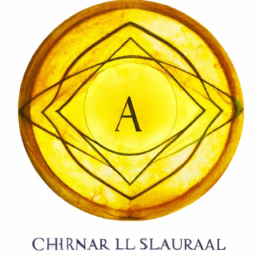The Solar Plexus Chakra, also known as Manipura in Sanskrit, is the third primary chakra in the human body. It is located in the upper abdomen area, above the navel and below the rib cage. The name Solar Plexus comes from the Greek word “sōlar” meaning sun and ”plēksos” meaning “weaving together”. This chakra is associated with the element of fire and is responsible for our sense of self, personal power, and transformation.
The symbol of the Solar Plexus Chakra is a bright yellow circle with ten petals, representing the ten pranas or vital forces in the body. Inside the circle, there is a downward-pointing triangle, with the apex connecting to a smaller circle. This symbol represents the powerful energy and fire within us, which radiates outwards and connects us to the universe.
The yellow color of the Solar Plexus Chakra symbol is not a coincidence. It is the color of sunshine, representing warmth, cheerfulness, and optimism. Just like the sun, this chakra is the source of life and vitality within us. It is the center of our personal power and self-confidence, giving us the strength and courage to face challenges and achieve our goals.
The downward-pointing triangle in the symbol signifies the balance between mind, body, and spirit, with the apex representing the transcendent point where all three meet. This balance is essential in achieving a strong and healthy Solar Plexus Chakra. When this chakra is balanced, we are able to think clearly, make decisions confidently, and take action towards our personal growth.
The smaller circle within the triangle represents the element of fire, which is associated with this chakra. Fire symbolizes transformation and purification, as it has the ability to destroy and renew. Similarly, the Solar Plexus Chakra is responsible for our personal transformation, guiding us to let go of negative patterns and embrace our true self.
The ten petals in the chakra symbol represent the ten pranas or vital energies in the body. These energies flow through the nadis (energy channels), nourishing our physical, emotional, and spiritual well-being. When all ten pranas are in harmony, we experience a sense of balance and vitality in our lives.
When our Solar Plexus Chakra is blocked or imbalanced, we may experience physical, emotional, or spiritual symptoms. Some common physical symptoms include digestive issues, stomach ulcers, and gallbladder problems. Emotionally, we may struggle with low self-esteem, lack of motivation, and indecisiveness. Spiritually, we may feel disconnected and lack a sense of purpose in life.
To balance and heal this chakra, there are various techniques and practices that one can incorporate into their daily routine. Yoga poses, such as the Warrior III pose, stimulates and activates the Solar Plexus Chakra. Deep breathing exercises and visualization techniques, such as imagining a bright yellow light glowing from the chakra, can also help to balance its energy.
In addition, practicing self-love and positive affirmations can also have a significant impact on the health of our Solar Plexus Chakra. By recognizing our own strengths, talents, and unique qualities, we can boost our self-confidence and personal power.
In conclusion, the Solar Plexus Chakra symbol holds great significance and meaning in the study of chakras. It represents the balance, transformation, and vitality that this chakra brings into our lives. By understanding and working towards balancing this chakra, we can tap into our inner fire and unleash our true potential. So let the light of the Solar Plexus Chakra symbol guide you on your journey of self-discovery and transformation.





Interesting post! #loveit #enthralling
sleeplesssputnik: Wow, very informative and detailed.
#wowza – This post is fascinating and really deep!